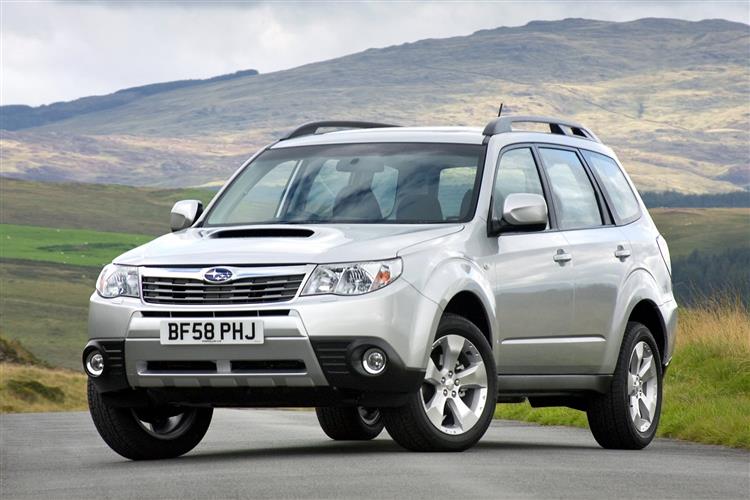GET A GRIP (some text hidden) --NONE--
BY STEVE WALKER
Introductionword count: 92
Evolution is everywhere in the motor industry with technology advancing and as patterns of customer demand change, cars adapt to stay relevant and desirable. It's usually a gradual process but occasionally a more dramatic leap is called for and in 2008, Subaru thought its Forester needed just such a metamorphosis. The Subaru Forester had always been an unusual proposition but it was closer to a four-wheel-drive estate car than anything else. The third generation model which showed up in April 2008 wasn't. The Forester had unmistakably been transformed into a compact SUV.
Modelsword count: 12
Models Covered: 5-door SUV: 2.0 petrol, 2.0D diesel [X, XS, XC, XSn])
Historyword count: 252
Fans of the Forester's mix of no-nonsense ruggedness and turbocharged performance may have been slightly flummoxed by its 2008 incarnation but it gained Subaru admission to the compact 4x4 market sector which was firmly on the up at the time. The previous two Forester generations had been spacious estates with Subaru's all-wheel-drive mechanicals and range-topping versions powered by the turbocharged petrol engines that made Subaru's Impreza the budget performance star it was. There wasn't much else for the price that could give that mix of on-road performance, practicality and off-road ability, so the Forester always had a small but profitable niche in the UK market. The third generation Forester arrived in 2008 and was obviously very different to the cars that had carried the Forester name before it. Here was a taller vehicle with the classic SUV shape and high driving position. It arrived in April 2008 with a 2.0-litre petrol engine but the crucial diesel model showed up in September of that year. Previous Foresters had always been handicapped by their lack of a diesel option and it was obvious that the Forester would need one now that it was a smaller fish in the large and growing compact SUV pond. X and XS trim levels were offered and the Forester continued to campaign on the basis that it was the driver's choice amongst its compact 4x4 rivals. The mid-range XC trim level arrived later and was offered with the diesel engine while XSn is basically the XS with satellite navigation.
What You Getword count: 275
The very first thing that's apparent when clocking this Forester is that the rising waistline and broader front end have given it more of a generic compact 4x4 stance. In fact it's fully 110mm taller than the second generation model, 45mm wider and has another 90mm grafted into the wheelbase. This significant enlargement increased interior space and practicality. Rear passenger space is very generous and there's a 450-litre boot that can be extended by folding down the 60/40 spilt rear bench. The styling is neat, albeit with a rather bland front end. Perhaps this was deliberate after the mixed response to the B9 Tribeca, Subaru's previous foray into the SUV arena. Interior design has never been a Subaru strongpoint and the Forester was never going to challenge for class honours in this area. The cabin is neat and reasonably well finished with a brushed aluminium-look centre console and a big driver information system near the top of the dashboard. The materials used aren't on a par with the best compact SUVs, however. Apart from the expected symmetrical all-wheel drive system, all versions get Subaru Vehicle Dynamics Control, self-levelling rear suspension, fuel-saving electric power steering and 16" alloy wheels. You can also expect to find all-round electric windows, 60/40-split rear seats with reclining back-rests, climate-control air-conditioning, a decent CD stereo, front fog lamps, a vehicle information display, a leather-covered height and reach-adjustment steering wheel, heated front seats, mirrors and windscreen wipers plus cruise-control. In the XC, you get bigger alloys, a better stereo and a full-length sunroof, while the pricey XSn adds leather seats and satellite navigation. For the price, all Foresters were very well equipped.
To see the full road test text contact us on 0330 0020 227
Pictures (high res disabled)

.jpg)
|
.jpg)
|
.jpg)
| |||
.jpg)
|
Statistics (subset of data only)
Min |
Max |
|
Insurance group 1-50: |
19 |
23 |
CO2 (g/km): |
155 |
174 |
Max Speed (mph): |
116 |
|
0-62 mph (s): |
10.4 |
12.4 |
Urban Mpg: |
29.1 |
39.8 |
Extra Urban Mpg: |
44.1 |
54.3 |
Combined Mpg: |
37.7 |
47.9 |
Length (mm): |
4560 |
|
Width (mm): |
1780 |
|
... and 4 other stats available | ||
Scoring (subset of scores)
Category: Crossover or SUV 4x4s
| Performance | |
| Handling | |
| Comfort | |
| Space | |
| Styling, Build, Value, Equipment, Depreciation, Handling, Insurance and Total scores are available with our full data feed. | |



